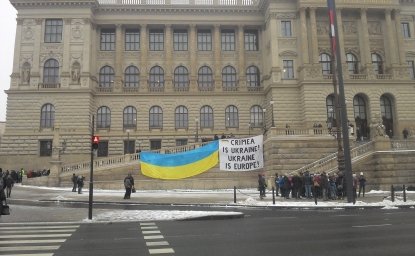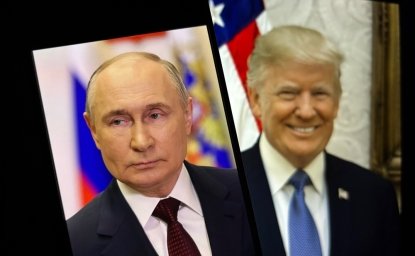Defining Surzhyk in Contemporary Ukraine

Language mixing is a worldwide phenomenon that spans a continuum from pragmatic shifting between languages to grammatical regularization of a new language, said Laada Bilaniuk, Assistant Professor of Anthropology at the University of Washington and Shklar Research Fellow at the Harvard Ukrainian Research Institute, at a Kennan Institute lecture on 11 March 2002. The
Ukrainian-Russian mixed language, or surzhyk, is not unique. However, Bilaniuk explained that defining surzhyk as simply a language mix of Ukrainian and Russian is oversimplified, as it includes several varied phenomena.
According to Bilaniuk, language ideology is key to understanding surzhyk in contemporary Ukraine. She explained that the study of language ideology goes beyond objective linguistic facts to consider what people believe about language and how they judge others' language use. The definition of surzhyk in Ukraine today is therefore determined by the pervasive discourse oflinguistic purism. Bilaniuk noted that when Ukrainian was made the state language, people strove to separate it from its rural and unprestigious roots. The purist attitude rejects any aspects of language that would connect it with low socio-economic status or ethnic inauthenticity. The focus on purism stigmatizes mixing and increases the range of language use that is considered surzhyk.
Bilaniuk went on to describe five types of language use that can be considered surzhyk inUkraine today. The first is what Bilaniuk called "urbanized peasant surzhyk." This surzhykblends features of Ukrainian and Russian on all linguistic levels. It came about when industrialization and urbanization brought Ukrainian-speaking peasants into contact withRussian-speaking administrators. In urban areas, Ukrainian was considered provincial. Adultmigrants therefore attempted to speak Russian, but did not master all the grammatical intricacies of the language. Bilaniuk noted that this surzhyk persisted into the second generation as well. Even though the children of migrants learned to speak pure Russian or Ukrainian in school, their home language remained a mixture of the two. She explained that because of these roots, urbanized peasant surzhyk connotes lower socio-economic status.
A second form of language mixing is "village dialect surzhyk," a type of mixed language thathas been regularized. In some villages this surzhyk resulted from peasants coming into contactwith Russian speaking administrators. But Bilaniuk suggested that it was a more complexprocess, as there is some indication that some of the "mixed" features of village dialects may predate the introduction of standardized Russian and Ukrainian languages.
Bilaniuk then identified "Sovietized Ukrainian surzhyk," which is most often singled out bylanguage purists. In the 1930s, words that were considered "bourgeois nationalist" were purgedfrom dictionaries and replaced with their Russian counterparts or versions most similar to the Russian. Bilaniuk provided anecdotal evidence that this process continued throughout the Sovietperiod, when scholarly works were edited to replace Ukrainian with Russian terms. She notedthat as a result of these policies, purists feel that the Ukrainian commonly used today is itself a form of surzhyk.
The fourth category of surzhyk identified by Bilaniuk is "habitual language mixing" by bilinguals. She explained that this includes people who are usually bilingual but regularly borrow terms from one language into another out of habit or to serve social functions. In this case, Bilaniuk stressed that judging someone's language usage as "surzhyk" depends on attitudestowards that person and their perceived ability to speak pure Ukrainian.
Finally, Bilaniuk described "post-independence surzhyk." This is a new phenomenon brought about by the new state status of Ukrainian. Russian-speaking adults are now trying to speak Ukrainian. What results is often a mixed language where grammatical forms and terms that thespeaker does not know in Ukrainian are borrowed from Russian. Bilaniuk differentiated this type of surzhyk from the others because it involves language shift from Russian to Ukrainian (thereverse of the other categories), and it is often spoken by people of a higher economic status
without any connection to villages.
Bilaniuk concluded with data on the demographic significance of surzhyk speakers in Ukraine. She noted that it is often difficult to get data on surzhyk because individuals do not want to admit to speaking a stigmatized language. In a survey conducted across Ukraine in 1995, less than 1 percent of respondents wrote in surzhyk as their native language. However, when provided choices for language use at home, 10 percent chose "mixed language (surzhyk)," 2 percent chose that category and Russian or Ukrainian, and another 16 percent chose "sometimes Ukrainian, sometimes Russian." Bilaniuk's surveys established that between 12 and 28 percent of respondents either mix languages or alternate between languages at home.
Author

Kennan Institute
After more than 50 years as a vital part of the Wilson Center legacy, the Kennan Institute has become an independent think tank. You can find the current website for the Kennan Institute at kennaninstitute.org. Please look for future announcements about partnership activities between the Wilson Center and the Kennan Institute at Wilson Center Press Room. The Kennan Institute is the premier US center for advanced research on Eurasia and the oldest and largest regional program at the Woodrow Wilson International Center for Scholars. The Kennan Institute is committed to improving American understanding of Russia, Ukraine, Central Asia, the South Caucasus, and the surrounding region through research and exchange. Read more

Explore More
Browse Insights & Analysis
The OSCE is a Good Value for America

Infographic | Russia's Illegal Annexation of Crimea

Russia’s Indigenous Communities and the War in Ukraine
